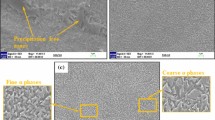Abstract
Different aging heat treatments were performed in a Titanium alloy using as aging media metallic baths in comparison to typical furnace aging. As a first step, a Duplex Aging (DA) consisted of solubilization followed by quenching to room temperature after aging heat treatment in different metallic baths (Zn, Sn and Bi). A second procedure was Alternative Aging (AA) which consisted of solubilization and direct aging inside three different aforementioned baths. Microstructural aging variations begins at half hour until 30 h at 550°C inside metallic bath of Zn, Sn or Bi. Both kinds of aging promoted a microstructural variation and so on microhardness values. Microstructural analysis by Optical Microscopy showed a structural refinement after AA treatment. The highest hardness value of 375 HVN was achieved in Alternative Aging with Zn bath, which was found to be dependent on laminar α phase refining. Moreover, after AA treatment for 0.5, 1, 2, 3, 4, 10 and 30 h at 550°C in the metallic bath of Zn and Sn, the results indicated similar hardness values in different times, resulting in the fastest kinetic for Sn metallic bath at 2 h compared to that 4 h in Zn metallic bath. The observed increase in micro-hardness is not very attractive, it is recommended to use large aging times in order to stabilize final spacing of microstructural features in AA treatment.
Similar content being viewed by others
References
H. J. Rack, Titanium alloys for biomedical applications, USA. Materials Science & Engineering, 1269–1277 (2006).
R. Nunes, Properties and Selection: Nonferrous Alloys and Special-Purpose Materials, ASM Handbook, 1770–1774 (1990).
G. E. Marchetti, Biomateriales en cirugía Ortopédica, Elsevier Masson., 10–24 (2010).
R. Reda, Journal of Metallurgical Engineering, 2, 48–54 (2013).
H. K. Contributors, Mechanical Testing and Evaluation, 8, 162–174 (2000).
T. Morita, Japan Institute of metals: Materials Transactions, 46, 1681–1686 (2005).
ASTM F-136 Standard specification for wrought titanium-6Aluminium-4Vanadium ELI (Extra Low Interstitial) for surgical implant applications. USA 2013.
ASTM E-384 International, Standard Test Methods for Vickers Hardness of Metallic Materials, USA, 2003, pp. 309–314.
R. Reda, Metallography, Microstructure and Analysis, 388–393 (2013).
R. Filip, Journal of Materials Processing Technology, 133, 84–89 (2003).
Author information
Authors and Affiliations
Corresponding author
Rights and permissions
About this article
Cite this article
Sánchez-Rosas, T.J., Muñoz-Andrade, J.D., Aguilar-Sánchez, M. et al. Effect of the Metallic Aging on the Microstructure and Mechanical Properties of Titanium Alloy. MRS Advances 2, 2837–2845 (2017). https://doi.org/10.1557/adv.2017.520
Published:
Issue Date:
DOI: https://doi.org/10.1557/adv.2017.520




